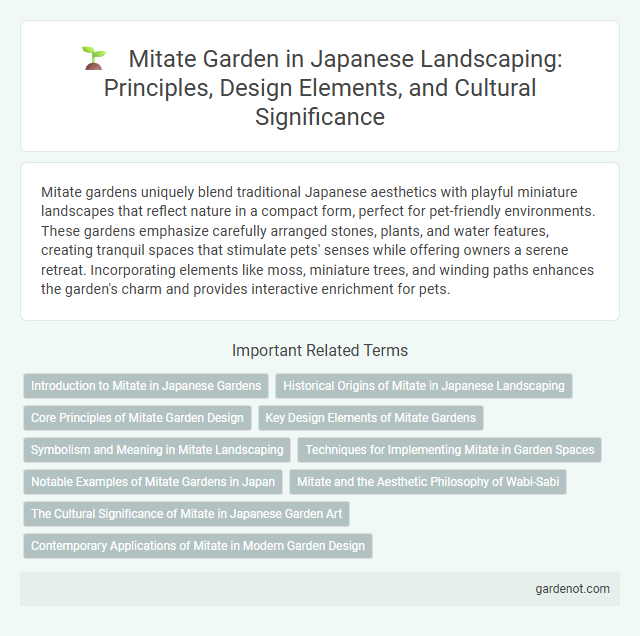Mitate gardens uniquely blend traditional Japanese aesthetics with playful miniature landscapes that reflect nature in a compact form, perfect for pet-friendly environments. These gardens emphasize carefully arranged stones, plants, and water features, creating tranquil spaces that stimulate pets' senses while offering owners a serene retreat. Incorporating elements like moss, miniature trees, and winding paths enhances the garden's charm and provides interactive enrichment for pets.
Introduction to Mitate in Japanese Gardens
Mitate gardens in Japanese landscaping exemplify the art of imaginative substitution, where natural elements symbolize broader concepts or scenes. These gardens use small-scale arrangements to evoke vast landscapes, blending rocks, plants, and water features with layered meaning. The mitate approach enhances spiritual reflection and aesthetic appreciation through symbolic representation and creative perspective shifts.
Historical Origins of Mitate in Japanese Landscaping
Mitate gardens trace their origins to the Edo period in Japan, embodying a sophisticated form of metaphorical landscaping that reinterprets natural elements on a smaller scale. This style reflects the Zen Buddhist influence on Japanese gardening, emphasizing abstraction and the evocation of landscapes through symbolic plant arrangements and stone placements. Mitate's historical development highlights cultural appreciation for miniaturization and poetic expression within traditional Japanese garden design.
Core Principles of Mitate Garden Design
Mitate garden design emphasizes miniature landscapes that encapsulate the essence of nature through symbolic elements like rocks, water features, and carefully pruned plants. The core principles include wabi-sabi, highlighting rustic simplicity and imperfection, and shakkei, or borrowed scenery, which integrates the surrounding environment into the garden's aesthetic. Spatial harmony and asymmetry create dynamic visual interest while evoking tranquility and contemplation.
Key Design Elements of Mitate Gardens
Mitate gardens in Japan feature miniature landscapes that symbolically represent natural scenes, using carefully arranged rocks, water elements, and plants to evoke mountains, rivers, and forests. Key design elements include asymmetrical compositions, symbolic use of space, and seasonal plantings that highlight wabi-sabi aesthetics of simplicity and impermanence. The integration of borrowed scenery (shakkei) enhances the garden's depth, creating a seamless blend between the miniature and the natural environment.
Symbolism and Meaning in Mitate Landscaping
Mitate gardens in Japanese landscaping symbolize the art of reinterpretation, where everyday objects and natural elements are transformed to represent larger concepts or historical scenes. The deliberate arrangement of stones, plants, and water features evokes layered meanings, blending poetic imagination with cultural references. This symbolic approach encourages contemplative engagement, inviting viewers to discover multiple interpretations within the garden's miniature landscape.
Techniques for Implementing Mitate in Garden Spaces
Mitate garden design employs techniques such as creative juxtaposition, where elements symbolizing vast landscapes or scenes are miniaturized to evoke layered meaning within limited spaces. Designers incorporate borrowed scenery (shakkei) and asymmetrical balance to create illusions of depth and narrative, enhancing the viewer's engagement with symbolic motifs. Careful placement of stones, plants, and water features follows traditional principles like wabi-sabi to harmonize natural imperfections with imaginative reinterpretation of familiar forms.
Notable Examples of Mitate Gardens in Japan
Mitate gardens, characterized by their symbolic representation of famous landscapes through miniature elements, are exemplified by the renowned Oyamazaki Villa Garden in Kyoto and the Kokedera (Moss Temple) Garden. These gardens ingeniously combine rocks, plants, and water features to evoke natural scenery, reflecting the core principles of Japanese aesthetics such as wabi-sabi and shakkei (borrowed scenery). Notable for their artistic interpretation and cultural heritage, Mitate gardens are pivotal in the study of traditional Japanese garden design.
Mitate and the Aesthetic Philosophy of Wabi-Sabi
Mitate garden embodies the Wabi-Sabi aesthetic philosophy by embracing imperfection, transience, and simplicity through carefully curated natural elements. This garden style reinterprets conventional motifs, creating a microcosm that evokes profound beauty in humble materials and asymmetrical designs. The subtle interplay of weathered textures and seasonal changes in Mitate gardens reflects the refined appreciation of fleeting moments central to Wabi-Sabi.
The Cultural Significance of Mitate in Japanese Garden Art
Mitate gardens embody the Japanese aesthetic principle of mitate, which involves playful reinterpretation and layering of meanings through miniature landscapes and symbolic elements. These gardens serve as cultural narratives, blending historical references with natural motifs to evoke deeper emotional and intellectual responses. Mitate reflects the Zen Buddhist appreciation for impermanence and subtle beauty, making these gardens a profound expression of Japanese artistic and philosophical values.
Contemporary Applications of Mitate in Modern Garden Design
Mitate gardens employ symbolic miniatures to create layered meanings, often reinterpreting classical Japanese motifs through modern materials and spatial arrangements. Contemporary garden designers integrate mitate by combining traditional elements like stones, water features, and plants with abstract forms and urban aesthetics, enhancing contemplative spaces in compact environments. This fusion supports cultural storytelling while addressing functional aspects of modern living, exemplifying innovative expressions within Japanese garden art.
Mitate garden Infographic

 gardenot.com
gardenot.com